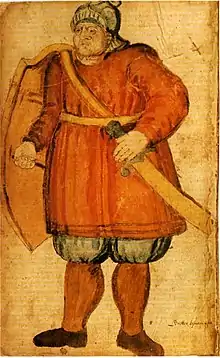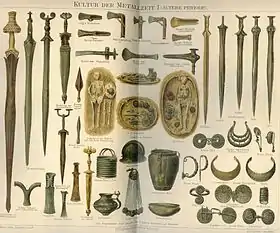Barrow-wight
Barrow-wights are wraith-like creatures, best-known from J. R. R. Tolkien's world of Middle-earth. In The Lord of the Rings, the four hobbits are trapped by a barrow-wight, and are lucky to escape with their lives; but they gain ancient swords of Westernesse for their quest.
Tolkien derived the idea of barrow-wights from Norse mythology, where heroes of several sagas battle the undead. Barrow-wights do not appear in Peter Jackson's film trilogy, but they do feature in computer games based on Tolkien's Middle-earth.
Origins

A barrow is simply a burial mound, such as was used in Neolithic times.[2] A wight, from Old English: wiht, is a person or other sentient being.[3][4]
There are tales of wights, called vǣttr or draugr, undead grave-spirits with bodies, in Norse mythology.[5][6][7][8] In Norway, country people in places such as Eidanger, Telemark considered that the dead went on living in their tombs as vetter or protective spirits, and up to modern times continued to offer sacrifices on the grave-mounds.[9]
Tolkien stated in his Nomenclature that "barrow-wight" was an "invented name", rather than one like "orc" that existed in Old English.[5] He explained further in a lecture on Beowulf that orcneas ("hell-corpses"), the evil monsters born of Cain and leading to the monster Grendel, meant:[T 1]
that terrible northern imagination to which I have ventured to give the name 'barrow-wights'. The 'undead'. Those dreadful creatures that inhabit tombs and mounds. They are not living: they have left humanity, but they are 'undead'. With superhuman strength and malice they can strangle men and rend them. Glámr in the story of Grettir the strong is a well-known example.[T 1]
However, the term was used by Andrew Lang in his 1891 Essays in Little, where he wrote "In the graves where treasures were hoarded the Barrowwights dwelt, ghosts that were sentinels over the gold."[5] Eiríkr Magnússon and William Morris used it, too, in their 1869 translation of Grettis saga, which features a fight with the "barrow-wight" or "barrow-dweller", Kárr:[10][11]
Everything in their way was kicked out of place, the barrow-wight setting on with hideous eagerness; Grettir gave back before him for a long time, till at last it came to this, that he saw it would not do to hoard his strength any more; now neither spared the other, and they were brought to where the horse-bones were, and thereabout they wrestled long. And now one, now the other, fell on his knee; but the end of the strife was, that the barrow-dweller fell over on his back with huge din.[11]
The Grettis Saga further links the defeat of the barrow-wight to the recovery of an ancient treasure, which comes to the sight of the heir of the house to which it had once belonged:[11]
Grettir ... cast down on the table all the treasure he had taken in the barrow; but one matter there was thereof, on which he must needs keep his eyes; this was a short sword, so good a weapon, that a better, he said, he had never seen; and this he gave up the last of all. Thorfinn was blithe to see that sword, for it was an heirloom of his house, and had never yet gone out of his kin.
"Whence came these treasures to thine hand?" said Thorfinn.[11]
The Grettis Saga calls the undead monsters Glámr and Kárr haugbúar ("mound-dwellers", singular haugbúi; a similar term is draugr). It clearly influenced Tolkien's barrow-wights, whether directly from the Old Norse or by way of Magnússon and Morris's translation.[12]
Both the barrow-wight and the character Tom Bombadil first appeared in Tolkien's writings in his poem The Adventures of Tom Bombadil, published in the Oxford Magazine of 15 February 1934.[T 2][13]
Lord of the Rings narrative
.jpg.webp)
Evil spirits were sent to the Barrow-downs by the Witch-king of Angmar to prevent the restoration of the destroyed Dúnedain kingdom of Cardolan, one of three remnants of the Dunedain Kingdom of Arnor.[T 3][T 4] They animated the dead bones of the Dúnedain, as well as older bones of Edain from the First Age, which still were buried there.[T 4]
After leaving Tom Bombadil, Frodo Baggins and company are trapped in the Barrow-downs, and nearly brutally killed by a barrow-wight:[T 3]
Suddenly he saw, towering ominous before him and leaning slightly towards one another like the pillars of a headless door, two huge standing stones... He had passed between them almost before he was aware: and even as he did so darkness seemed to fall round him.[T 3]
Frodo manages to resist the wight's spell; looking about, he sees the other hobbits dressed in grave-goods, in thin white clothes with gold circlets and chains, swords and shields around them, and a sword lying across their necks. He seizes a small sword and cuts off the wight's hand. When the wight extinguishes the dim light in the cavern, Frodo calls for Tom Bombadil, who expels the wight from the barrow, rescues the hobbits, and recovers the wight's treasure-hoard, which included ancient Númenórean swords. Frodo sees the separated hand continuing to wriggle by itself.[T 3][14]
The cairn was that of the last prince of Cardolan;[T 4] Merry's exclamation on waking from his trance confirms this, as he names Carn Dûm, capital of the Witch-Kingdom of Angmar, continually at war with the Númenórean realms (and as Bombadil later explains):[T 3]
Of course, I remember! The men of Carn Dûm came on us at night, and we were worsted. Ah! The spear in my heart![T 3]

Bombadil arms the hobbits from the barrow-wight's hoard:
For each of the hobbits he chose a dagger, long, leaf-shaped, and keen, of marvellous workmanship, damasked with serpent-forms in red and gold. they gleamed as he drew them from their black sheaths, wrought of some strange metal, light and strong, and set with many fiery stones. Whether by some virtue in these sheaths or because of the spell that lay on the mound, the blades seemed untouched by time, unrusted, sharp, glittering in the sun.[T 3]
When, much later, Pippin offers his service to the Steward of Gondor, Denethor, the old man examines his sword and asks "Whence came this? ... Many, many years lie on it. Surely this is a blade wrought by our own kindred in the North in the deep past?"[T 5]
Significance
The Tolkien scholar Tom Shippey comments that it is a "great moment" when Merry awakens in the barrow from the wight's spell and "remembers only a death not his own". He observes that Merry has taken on the warrior's personality, not that of the wight, since Tom recalls the dead with affection. That leaves, Shippey writes, the question of who or what the wight was as a mystery. The deathly-white robes, the writhing hand, the hobbits arrayed for death, give the thrill of fantasy, but this is given solidity by being tied into a wider history which is at least hinted at.[14]
Patrick Callahan notes that the whole Bombadil episode seems disconnected from the rest of the story, but that the barrow-wight story resembles the final fight in Beowulf, when the king, now old, goes out to do battle with the barrow-dragon. He dies, but the funeral-barrow's treasure is recovered and the curse on it is broken, just as with the barrow-wight's. Callahan observes, too, that the barrow-wight belongs to "the class of revenants, or 'walking dead'", as in the Grettis saga which Tolkien knew.[1]
In other media
Barrow-wights are absent in Peter Jackson's The Lord of the Rings film trilogy. The scholar of humanities Brian Rosebury states that the removal is acceptable to reduce running time, because the episode does not fundamentally change the story.[15] The Tolkien scholar John Rateliff, on the other hand, writes that the result of omitting the scene shows that Tolkien's story is "too tightly woven and interlinked for whole episodes to be removed without consequences down the line". In this case, the hobbits' swords have to be provided by Aragorn, who gives them out just before the Ringwraiths arrive for the fight on Weathertop, which "raises the rather awkward question as to why Aragorn should happen to be carrying four hobbit-sized swords", not least as he had only been expecting to meet two of them, Frodo and Sam. Rateliff commented that the grim reaper scene inside the barrow "would seem tailor-made for [Jackson's] talents."[16]
Tom Shippey adds that in the book, it was "fortunate" that Merry happens to be armed with a blade specifically made "against 'the dread realm of Angmar and its sorcerer king'", i.e. the Lord of the Nazgûl, who he stabs, but that having lost the barrow-wight scene, Jackson cannot make any use of this.[17] In the story, the sword is consumed "like a dry branch that has been thrust in a fire":[T 6]
So passed the sword of the Barrow-downs, work of Westernesse. But glad would he have been to know its fate who wrought it slowly long ago in the North-kingdom when the Dunedain were young, and chief among their foes was the dread realm of Angmar and its sorcerer king. No other blade, not though mightier hands had wielded it, would have dealt that foe a wound so bitter, cleaving the undead flesh, breaking the spell that knit his unseen sinews to his will.[T 6]
Barrow-wights have however been included in games based on Tolkien's Middle-earth.[18]
References
Primary
- This list identifies each item's location in Tolkien's writings.
- Tolkien, J. R. R. (2014). Beowulf : a translation and commentary, together with Sellic spell. London: HarperCollins. pp. 163–164. ISBN 978-0-00-759006-3. OCLC 875629841.
- Tolkien, J. R. R. (2014). Scull, Christina; Hammond, Wayne G. (eds.). The Adventures of Tom Bombadil. Harper Collins. p. 123. ISBN 978-0007557271.
- The Fellowship of the Ring, book 1, ch. 8 "Fog on the Barrow-downs"
- The Return of the King, Appendix A, "The Númenorean Kings", "Eriador, Arnor, and the Heirs of Isildur"
- The Return of the King, book 5, ch. 1 "Minas Tirith"
- The Return of the King, book 5, ch. 6 "The Battle of the Pelennor Fields"
Secondary
- Callahan, Patrick J. (1972). "Tolkien, Beowulf, and the Barrow-Wights". Otre Dame English Journal. 7 (2): 4–13. JSTOR 40066567.
- "Barrow". Cambridge Dictionary. Retrieved 9 August 2020.
- "Wight". Merriam-Webster Dictionary. 1974.
- Hoad, T. F., ed. (1996). "Wight". The Concise Oxford Dictionary of English Etymology.
- Hammond, Wayne G.; Scull, Christina (2005). The Lord of the Rings: A Reader's Companion. HarperCollins. pp. 137, 142–146. ISBN 978-0-00-720907-1.
- Palsson, Hermann (1989). Eyrbyggja saga. Penguin. p. 187. ISBN 978-0-14-044530-5. OCLC 26857553.
- Byock, Jesse (2009). Grettir's saga. Oxford University Press. p. 115. ISBN 978-0-19-280152-4. OCLC 246897478.
- Magnússon, Magnús; Palsson, Hermann (1969). Laxdaela Saga. Penguin. p. 103. ISBN 978-0-14-044218-2. OCLC 6969727.
- Skjelsvik, Elizabeth (1968). Hals, Harald (ed.). Eidangers eldste historie: Bronse-alder (1500-500 f.Kr.) [Eidanger's oldest history: Bronze age (1500-500 B.C.)]. Eidanger bygdehistorie (in Norwegian). Porsgrunn kommune. section B.1. OCLC 4006470.
- "barrow". Online Etymology Dictionary. Retrieved 9 August 2020.
- Magnússon, Eiríkr; Morris, William (1869). Grettis Saga. The Story of Grettir the Strong, translated from the Icelandic. pp. 48–49.
- Fahey, Richard (5 March 2018). "Zombies of the Frozen North: White Walkers and Old Norse Revenants". University of Notre Dame. Retrieved 30 November 2020.
- Shippey, Tom (2005) [1982]. The Road to Middle-Earth (Third ed.). HarperCollins. pp. 119–120. ISBN 978-0261102750.
- Shippey, Tom (2005) [1982]. The Road to Middle-Earth (Third ed.). HarperCollins. p. 125. ISBN 978-0261102750.
- Rosebury, Brian (2003) [1992]. Tolkien: A Cultural Phenomenon. Palgrave. p. 215. ISBN 978-1403-91263-3.
- Rateliff, John D. (2011). Bogstad, Janice M.; Kaveny, Philip E. (eds.). Two Kinds of Absence: Elision & Exclusion in Peter Jackson's The Lord of the Rings. Picturing Tolkien: Essays on Peter Jackson's The Lord of the Rings Film Trilogy. McFarland. pp. 54–66. ISBN 978-0-7864-8473-7.
- Shippey, Tom (2005) [1982]. The Road to Middle-Earth (Third ed.). HarperCollins. p. 427. ISBN 978-0261102750.
- Mythprint. Mythopoeic Society. 1974. p. 13.
.jpg.webp)